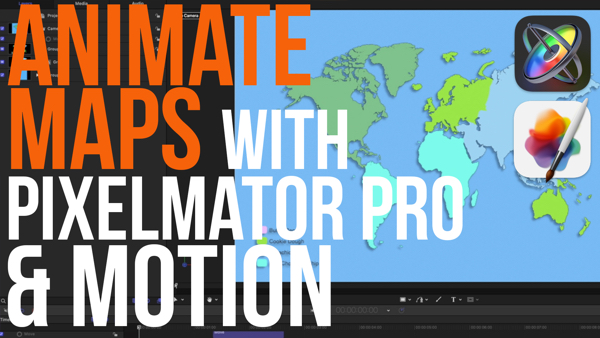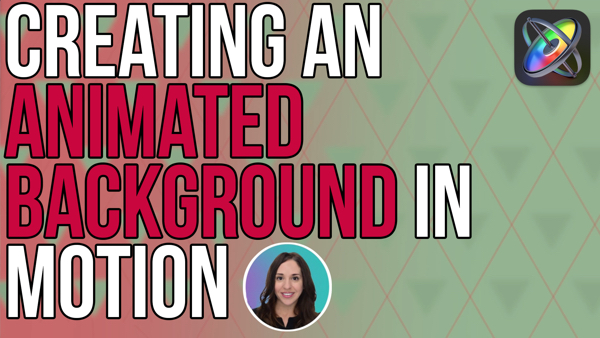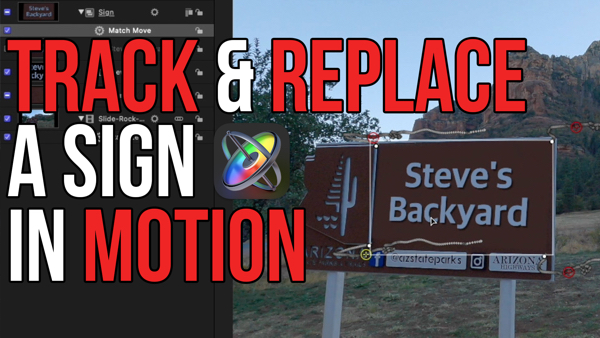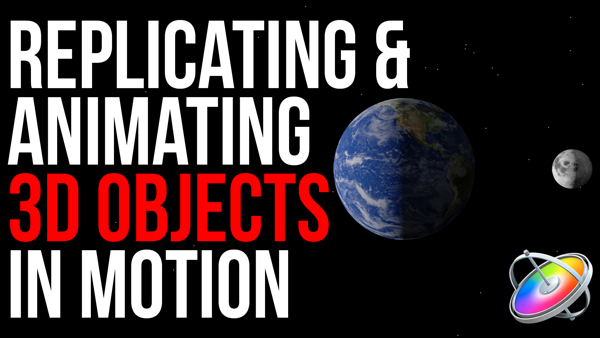How to Create a Deadly Evil Text
In “Under 5 Minutes” Mark Spencer will teach you how to create a scary, dripping text effect by revealing text with an image mask controlled by an animated paint stroke.
To make it even creepier, Marks makes some custom drip animations using the Shape Write On behavior. For a final touch, Mark applies an indent and bad film filter to give the titles a gritty texture and feel.
In this episode, I’ll show you how to make this scary evil text effect.
I’m Mark Spencer from RippleTraining.com, welcome to Motion Magic where you’ll learn visual effects and Motion graphics in “Under 5 Minutes”.
Here we are in Motion. I have a rotated and scaled text layer inside this Text group and an empty group named Drips. I’m using a font called Living Hell; we’ve included a link in the description below. To animate this text onto the screen, I’ll first select the Bezier tool and draw some lines that cover the text. I’ll press Return, then in the Heads Up Display, I’ll turn off the Fill, then from the Shape Style pop-up menu, I’ll choose Liquid, Ink Bleed 01 Heavy.
If I play the project, a series of white expanding blotches animate along the path I drew. I’ll use the HUD to change the color to a dark red and increase the width to 100. I’ll also save this red color because I’ll need it later.
In the Inspector’s Shape tab, in the Stroke section, I’ll increase the Jitter to about 400% to spread out the blotches. Let’s play that
To speed up the animation I’ll press F6 to open up the timeline, I’ll move the playhead to about 1 second, then I’ll drag this second keyframe back to the playhead.
That’s better.
To get rid of these black outlines around each of the red splotches, I’ll select the Media tab, select the Ink Bleed movie, then in the Media Inspector, change the Alpha Type from Straight to Premultiplied with Black. Then I’ll return to the Layers list.
To have the text revealed by the red blotches, I’ll select the Bezier layer, choose Object, Add Image Mask, then drag the text layer to the well in the HUD. Now when I play, the text is revealed by the animated paint stroke.
To create the dripping blood streaks, I’ll move the playhead home, select the Drips group, select the Line tool, hold down the Shift key, then click-drag to create a long vertical stroke.
I’ll press Escape to exit the tool.
I want the line to start thick and taper down. So first, in the Shape Inspector, in the Style tab, I’ll change the Brush Type to Airbrush, then open the Brush Profile and drag the white opacity tag right to create a sharper edge.
Then, I’ll increase the Width to make it thicker, and decrease the Spacing to eliminate the bumps. And I’ll change the Brush Color by selected the red swatch I had saved earlier.
Now, in the Stroke tab, I’ll open Width Over Stroke, drag down the right-hand keyframe to make the stroke skinner at the end, then Command-drag out bezier handles to adjust how quickly the stroke changes from thick to thin, to look more like a dripping liquid.
To animate the stroke, I’ll use the Behavior shortcut menu and select Shape, Write On. I’ll move the playhead to about 3 seconds and press O to trim the behavior. In the HUD, I’ll set the Speed to Decelerate for a more natural dripping action. Let’s see how that looks.
Great.
To make multiple drips of different sizes and in different positions, I’ll make clones of this master clip. First, I’ll deactivate it. Then I’ll select it and press K to make a clone, then move and scale the clone. And I’ll repeat that a few times.
Now in the Timeline I’ll stagger the cloned clips to come on at different times after the text appears. Let’s play that back.
Ok,to give the text and drips more depth, I’ll close and select both groups, then from the Object menu select Group to place everything in a single group. Then from the Filter shortcut menu I’ll choose Stylize, Indent, and adjust the settings in the HUD.
And to create an old-fashioned feel, once again from the Filter shortcut menu I’ll now choose Stylize, Bad Film and adjust the settings in the HUD. Let’s see how that looks.
Click the subscribe button below. If you have an idea, comment or suggestion, leave those below as well. Go to RippleTrainging.com for fast professional training on Final Cut Pro, Motion and Davinci Resolve from industry professionals.
I’m Mark Spencer from RippleTraining.com, welcome to Motion Magic where you’ll learn visual effects and Motion graphics in “Under 5 Minutes”.
Here we are in Motion. I have a rotated and scaled text layer inside this Text group and an empty group named Drips. I’m using a font called Living Hell; we’ve included a link in the description below. To animate this text onto the screen, I’ll first select the Bezier tool and draw some lines that cover the text. I’ll press Return, then in the Heads Up Display, I’ll turn off the Fill, then from the Shape Style pop-up menu, I’ll choose Liquid, Ink Bleed 01 Heavy.
If I play the project, a series of white expanding blotches animate along the path I drew. I’ll use the HUD to change the color to a dark red and increase the width to 100. I’ll also save this red color because I’ll need it later.
In the Inspector’s Shape tab, in the Stroke section, I’ll increase the Jitter to about 400% to spread out the blotches. Let’s play that
To speed up the animation I’ll press F6 to open up the timeline, I’ll move the playhead to about 1 second, then I’ll drag this second keyframe back to the playhead.
That’s better.
To get rid of these black outlines around each of the red splotches, I’ll select the Media tab, select the Ink Bleed movie, then in the Media Inspector, change the Alpha Type from Straight to Premultiplied with Black. Then I’ll return to the Layers list.
To have the text revealed by the red blotches, I’ll select the Bezier layer, choose Object, Add Image Mask, then drag the text layer to the well in the HUD. Now when I play, the text is revealed by the animated paint stroke.
To create the dripping blood streaks, I’ll move the playhead home, select the Drips group, select the Line tool, hold down the Shift key, then click-drag to create a long vertical stroke.
I’ll press Escape to exit the tool.
I want the line to start thick and taper down. So first, in the Shape Inspector, in the Style tab, I’ll change the Brush Type to Airbrush, then open the Brush Profile and drag the white opacity tag right to create a sharper edge.
Then, I’ll increase the Width to make it thicker, and decrease the Spacing to eliminate the bumps. And I’ll change the Brush Color by selected the red swatch I had saved earlier.
Now, in the Stroke tab, I’ll open Width Over Stroke, drag down the right-hand keyframe to make the stroke skinner at the end, then Command-drag out bezier handles to adjust how quickly the stroke changes from thick to thin, to look more like a dripping liquid.
To animate the stroke, I’ll use the Behavior shortcut menu and select Shape, Write On. I’ll move the playhead to about 3 seconds and press O to trim the behavior. In the HUD, I’ll set the Speed to Decelerate for a more natural dripping action. Let’s see how that looks.
Great.
To make multiple drips of different sizes and in different positions, I’ll make clones of this master clip. First, I’ll deactivate it. Then I’ll select it and press K to make a clone, then move and scale the clone. And I’ll repeat that a few times.
Now in the Timeline I’ll stagger the cloned clips to come on at different times after the text appears. Let’s play that back.
Ok,to give the text and drips more depth, I’ll close and select both groups, then from the Object menu select Group to place everything in a single group. Then from the Filter shortcut menu I’ll choose Stylize, Indent, and adjust the settings in the HUD.
And to create an old-fashioned feel, once again from the Filter shortcut menu I’ll now choose Stylize, Bad Film and adjust the settings in the HUD. Let’s see how that looks.
Click the subscribe button below. If you have an idea, comment or suggestion, leave those below as well. Go to RippleTrainging.com for fast professional training on Final Cut Pro, Motion and Davinci Resolve from industry professionals.




